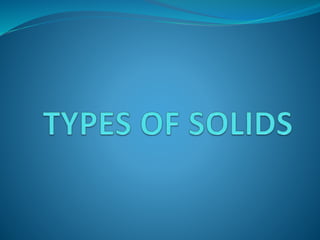TYPES OF SOLIDS.pptx
•Download as PPTX, PDF•
0 likes•61 views
types of solids
Report
Share
Report
Share

Recommended
Recommended
More Related Content
Similar to TYPES OF SOLIDS.pptx
Similar to TYPES OF SOLIDS.pptx (20)
Solid State & Solution_Unit 1-2_Class-12_Board-JEE-NEET

Solid State & Solution_Unit 1-2_Class-12_Board-JEE-NEET
6. Solid State Pharmaceutics A) Molecular Level AYP.pptx

6. Solid State Pharmaceutics A) Molecular Level AYP.pptx
CHEMICAL ENGG. MATERIALS- CRYSTALLINE & NON-CRYSTALLINE SOLIDS

CHEMICAL ENGG. MATERIALS- CRYSTALLINE & NON-CRYSTALLINE SOLIDS
Gseb class 12 chemistry sem 3 ch 1 solid state part 1

Gseb class 12 chemistry sem 3 ch 1 solid state part 1
Recently uploaded
Recently uploaded (20)
development of diagnostic enzyme assay to detect leuser virus

development of diagnostic enzyme assay to detect leuser virus
The Mariana Trench remarkable geological features on Earth.pptx

The Mariana Trench remarkable geological features on Earth.pptx
Call Girls Ahmedabad +917728919243 call me Independent Escort Service

Call Girls Ahmedabad +917728919243 call me Independent Escort Service
Role of AI in seed science Predictive modelling and Beyond.pptx

Role of AI in seed science Predictive modelling and Beyond.pptx
TransientOffsetin14CAftertheCarringtonEventRecordedbyPolarTreeRings

TransientOffsetin14CAftertheCarringtonEventRecordedbyPolarTreeRings
Climate Change Impacts on Terrestrial and Aquatic Ecosystems.pptx

Climate Change Impacts on Terrestrial and Aquatic Ecosystems.pptx
LUNULARIA -features, morphology, anatomy ,reproduction etc.

LUNULARIA -features, morphology, anatomy ,reproduction etc.
Selaginella: features, morphology ,anatomy and reproduction.

Selaginella: features, morphology ,anatomy and reproduction.
300003-World Science Day For Peace And Development.pptx

300003-World Science Day For Peace And Development.pptx
THE ROLE OF BIOTECHNOLOGY IN THE ECONOMIC UPLIFT.pptx

THE ROLE OF BIOTECHNOLOGY IN THE ECONOMIC UPLIFT.pptx
TYPES OF SOLIDS.pptx
- 2. There are two main classes of solids: crystalline and amorphous. What distinguishes them from one another is the nature of their atomic-scale structure.
- 3. AMORPHOUS SOLID • Amorphous are solids in which the particles are not arranged in any specific order or the solids that lack the overall order of a crystal lattice. • The term ‘amorphous’, when broken down into its Greek roots, can be roughly Translated to “without form”. Many polymers are amorphous solids. Other examples of such solids include glass, gels, and nanostructured materials. • Amorphous solids have two characteristic properties. When cleaved or broken, they produce fragments with irregular, often curved surfaces; and they have poorly defined patterns when exposed to x-rays because their components are not arranged in a regular array. An amorphous, translucent solid is called a glass. Almost any substance can solidify in amorphous form if the liquid phase is cooled rapidly enough. Some solids, however, are intrinsically amorphous, because either their components cannot fit together well enough to form a stable crystalline lattice or they contain impurities that disrupt the lattice. • In an amorphous solid, the local environment, including both the distances to neighboring units and the numbers of neighbors, varies throughout the material. Different amounts of thermal energy are needed to overcome these different interactions. Consequently, amorphous solids tend to soften slowly over a wide temperature range rather than having a well-defined melting point like a crystalline solid. If an amorphous solid is maintained at a temperature just below its melting point for long periods of time, the component molecules, atoms, or ions can gradually rearrange into a more highly ordered crystalline form.
- 4. PROPERTIES OF AMORPHOUS SOLID Lack of long-range order No sharp melting point
- 5. Examples of Amorphous Solids Amorphous solids comprise materials that are both natural and manmade. Like, ceramics, gels, polymers, rapidly quenched melts and thin-film systems deposited on a substrate at low temperatures. The investigation of amorphous materials is a very active area of research. Despite enormous progress in recent years our understanding of amorphous materials still remains far from complete. The reason is the absence of the simplifications associated with periodicity.
- 6. Difference between crystalline solid and amorphous solid Properties Crystalline solid Amorphous solid Structure The constituent particles, atoms ,ions or molecules are arranged in regular and definite three-dimensional patterns for example sodium, chloride , diamond, sugar and etc. The constituent particles are arranged in irregular three- dimensional patterns. Cutting with a knife Gives clean, sharp cleavage Unclean cleavage. Compressibility Rigid and incompressible Usually rigid and cannot be compressed to any appreciable extent. Melting point They have a sharp and definite melting point Melting point is not definite melt over a range of temperatures Heat of fusion Definite Not definite Physical properties This is are anisotropic in their physical properties are not identical in all direction. This are isotropic that is their physical properties are identical in all directions.
- 7. Solids are characterized by an extended three-dimensional arrangement of atoms, ions, or molecules in which the components are generally locked into their positions. The components can be arranged in a regular repeating three-dimensional array (a crystal lattice), which results in a crystalline solid, or more or less randomly to produce an amorphous solid. Crystalline solids have well-defined edges and faces, diffract x-rays, and tend to have sharp melting points. In contrast, amorphous solids have irregular or curved surfaces, do not give well-resolved x-ray diffraction patterns, and melt over a wide range of temperatures.
